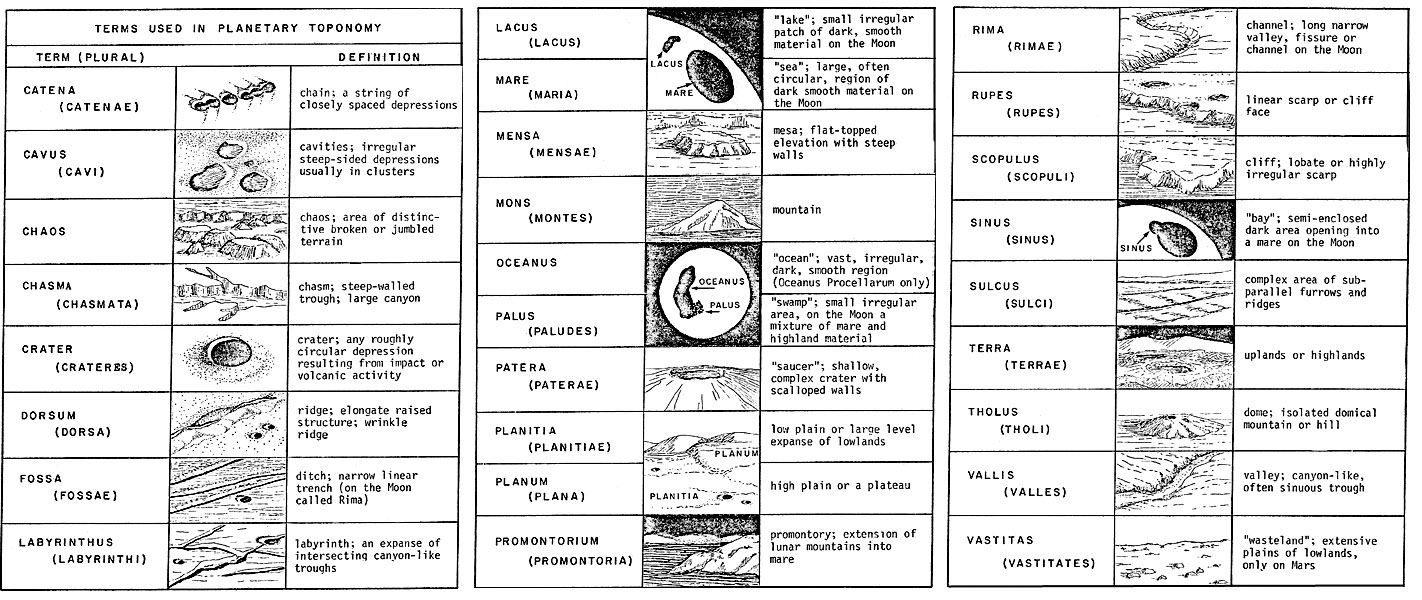Difference between revisions of "July 3, 2013"
| Line 1: | Line 1: | ||
__NOTOC__ | __NOTOC__ | ||
=Landform Types= | =Landform Types= | ||
| − | |||
<!-- ws:start:WikiTextHeadingRule:0:<h1> --> | <!-- ws:start:WikiTextHeadingRule:0:<h1> --> | ||
<!-- ws:start:WikiTextLocalImageRule:6:<img src="/file/view/LPOD-Jul3-13.jpg/440305794/LPOD-Jul3-13.jpg" alt="" title="" /> -->[[File:LPOD-Jul3-13.jpg|LPOD-Jul3-13.jpg]]<!-- ws:end:WikiTextLocalImageRule:6 --><br /> | <!-- ws:start:WikiTextLocalImageRule:6:<img src="/file/view/LPOD-Jul3-13.jpg/440305794/LPOD-Jul3-13.jpg" alt="" title="" /> -->[[File:LPOD-Jul3-13.jpg|LPOD-Jul3-13.jpg]]<!-- ws:end:WikiTextLocalImageRule:6 --><br /> | ||
| Line 8: | Line 7: | ||
If you can't tell a planitia from a dorsum this may be a chart for you. Back in 1979 when [http://lpod.wikispaces.com/April+7%2C+2012 Farouk El Baz] was heavily involved with planetary<br /> | If you can't tell a planitia from a dorsum this may be a chart for you. Back in 1979 when [http://lpod.wikispaces.com/April+7%2C+2012 Farouk El Baz] was heavily involved with planetary<br /> | ||
nomenclature he had his colleague Ann Gifford create this illustrated guide to descriptive terms for landforms. These are terms used on Mars<br /> | nomenclature he had his colleague Ann Gifford create this illustrated guide to descriptive terms for landforms. These are terms used on Mars<br /> | ||
| − | and other places as well as the Moon; in fact only about half of these descriptors were used for the Moon. Now the IAU recognizes [http://planetarynames.wr.usgs.gov/DescriptorTerms 55 types]<br /> | + | and other places as well as the Moon; in fact only about half of these descriptors were used for the Moon. Now the IAU recognizes [http://planetarynames.wr.usgs.gov/DescriptorTerms" rel="nofollow 55 types]<br /> |
of landforms - many from Saturn's satellites. This list was included as an appendix in the minutes of the 6th meeting of the IAU planetary<br /> | of landforms - many from Saturn's satellites. This list was included as an appendix in the minutes of the 6th meeting of the IAU planetary<br /> | ||
nomenclature group held in Montreal in August 1979. During that [http://the-moon.wikispaces.com/IAU+Transactions+XVIIB meeting] five new descriptor terms were introduced - <em>flexus, linea, macula,</em> <br /> | nomenclature group held in Montreal in August 1979. During that [http://the-moon.wikispaces.com/IAU+Transactions+XVIIB meeting] five new descriptor terms were introduced - <em>flexus, linea, macula,</em> <br /> | ||
<em>regio</em> and <em>terra</em>, and two others generally used were officially approved: <em>oceanus</em> and <em>solitudo</em>. Those who study lunar domes may recognize <br /> | <em>regio</em> and <em>terra</em>, and two others generally used were officially approved: <em>oceanus</em> and <em>solitudo</em>. Those who study lunar domes may recognize <br /> | ||
| − | Ann Gifford's name. While a student at Brown University she coauthored with Jim Head the classic 1980 [http://articles.adsabs.harvard.edu/cgi-bin/nph-iarticle_query?1980M%26P....22..235H&amp;data_type=PDF_HIGH&amp;whole_paper=YES&amp;type=PRINTER&amp;filetype=.pdf paper], <em>Lunar mare domes -</em><br /> | + | Ann Gifford's name. While a student at Brown University she coauthored with Jim Head the classic 1980 [http://articles.adsabs.harvard.edu/cgi-bin/nph-iarticle_query?1980M%26P....22..235H&amp;data_type=PDF_HIGH&amp;whole_paper=YES&amp;type=PRINTER&amp;filetype=.pdf" rel="nofollow paper], <em>Lunar mare domes -</em><br /> |
| − | <em>Classification and modes of origin.</em>Ann published a number of other valuable [http://adsabs.harvard.edu/cgi-bin/nph-abs_connect?db_key=AST&db_key=PRE&qform=AST&arxiv_sel=astro-ph&arxiv_sel=cond-mat&arxiv_sel=cs&arxiv_sel=gr-qc&arxiv_sel=hep-ex&arxiv_sel=hep-lat&arxiv_sel=hep-ph&arxiv_sel=hep-th&arxiv_sel=math&arxiv_sel=math-ph&arxiv_sel=nlin&arxiv_sel=nucl-ex&arxiv_sel=nucl-th&arxiv_sel=physics&arxiv_sel=quant-ph&arxiv_sel=q-bio&sim_query=YES&ned_query=YES&adsobj_query=YES&aut_logic=OR&obj_logic=OR&author=gifford%2C+a&object=&start_mon=01&start_year=1975&end_mon=12&end_year=1990&ttl_logic=OR&title=&txt_logic=OR&text=&nr_to_return=200&start_nr=1&jou_pick=ALL&ref_stems=&data_and=ALL&group_and=ALL&start_entry_day=&start_entry_mon=&start_entry_year=&end_entry_day=&end_entry_mon=&end_entry_year=&min_score=&sort=SCORE&data_type=SHORT&aut_syn=YES&ttl_syn=YES&txt_syn=YES&aut_wt=1.0&obj_wt=1.0&ttl_wt=0.3&txt_wt=3.0&aut_wgt=YES&obj_wgt=YES&ttl_wgt=YES&txt_wgt=YES&ttl_sco=YES&txt_sco=YES&version=1 studies], including an early paper with me on the [http://articles.adsabs.harvard.edu/cgi-bin/nph-iarticle_query?1980LPICo.414..121W&amp;data_type=PDF_HIGH&amp;whole_paper=YES&amp;type=PRINTER&amp;filetype=.pdf Big Backside Basin], <br /> | + | <em>Classification and modes of origin.</em>Ann published a number of other valuable [http://adsabs.harvard.edu/cgi-bin/nph-abs_connect?db_key=AST&db_key=PRE&qform=AST&arxiv_sel=astro-ph&arxiv_sel=cond-mat&arxiv_sel=cs&arxiv_sel=gr-qc&arxiv_sel=hep-ex&arxiv_sel=hep-lat&arxiv_sel=hep-ph&arxiv_sel=hep-th&arxiv_sel=math&arxiv_sel=math-ph&arxiv_sel=nlin&arxiv_sel=nucl-ex&arxiv_sel=nucl-th&arxiv_sel=physics&arxiv_sel=quant-ph&arxiv_sel=q-bio&sim_query=YES&ned_query=YES&adsobj_query=YES&aut_logic=OR&obj_logic=OR&author=gifford%2C+a&object=&start_mon=01&start_year=1975&end_mon=12&end_year=1990&ttl_logic=OR&title=&txt_logic=OR&text=&nr_to_return=200&start_nr=1&jou_pick=ALL&ref_stems=&data_and=ALL&group_and=ALL&start_entry_day=&start_entry_mon=&start_entry_year=&end_entry_day=&end_entry_mon=&end_entry_year=&min_score=&sort=SCORE&data_type=SHORT&aut_syn=YES&ttl_syn=YES&txt_syn=YES&aut_wt=1.0&obj_wt=1.0&ttl_wt=0.3&txt_wt=3.0&aut_wgt=YES&obj_wgt=YES&ttl_wgt=YES&txt_wgt=YES&ttl_sco=YES&txt_sco=YES&version=1" rel="nofollow studies], including an early paper with me on the [http://articles.adsabs.harvard.edu/cgi-bin/nph-iarticle_query?1980LPICo.414..121W&amp;data_type=PDF_HIGH&amp;whole_paper=YES&amp;type=PRINTER&amp;filetype=.pdf" rel="nofollow Big Backside Basin], <br /> |
more commonly called the South Pole - Aitken Basin.<br /> | more commonly called the South Pole - Aitken Basin.<br /> | ||
<br /> | <br /> | ||
| − | <em>[mailto:tychocrater@yahoo.com Chuck Wood]</em><br /> | + | <em>[mailto:tychocrater@yahoo.com" rel="nofollow Chuck Wood]</em><br /> |
Note: I thank Brad Smith for reminding me of this nice resource.<br /> | Note: I thank Brad Smith for reminding me of this nice resource.<br /> | ||
<br /> | <br /> | ||
<hr /> | <hr /> | ||
Revision as of 22:47, 4 January 2015
Landform Types

graphic by Ann Gifford, then at Air & Space Museum, Smithsonian Institution, Washington, D.C.
If you can't tell a planitia from a dorsum this may be a chart for you. Back in 1979 when Farouk El Baz was heavily involved with planetary
nomenclature he had his colleague Ann Gifford create this illustrated guide to descriptive terms for landforms. These are terms used on Mars
and other places as well as the Moon; in fact only about half of these descriptors were used for the Moon. Now the IAU recognizes " rel="nofollow 55 types
of landforms - many from Saturn's satellites. This list was included as an appendix in the minutes of the 6th meeting of the IAU planetary
nomenclature group held in Montreal in August 1979. During that meeting five new descriptor terms were introduced - flexus, linea, macula,
regio and terra, and two others generally used were officially approved: oceanus and solitudo. Those who study lunar domes may recognize
Ann Gifford's name. While a student at Brown University she coauthored with Jim Head the classic 1980 " rel="nofollow paper, Lunar mare domes -
Classification and modes of origin.Ann published a number of other valuable " rel="nofollow studies, including an early paper with me on the " rel="nofollow Big Backside Basin,
more commonly called the South Pole - Aitken Basin.
" rel="nofollow Chuck Wood
Note: I thank Brad Smith for reminding me of this nice resource.



